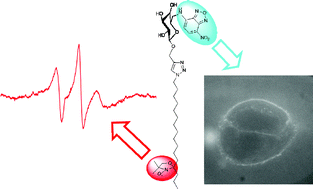A serious drawback of ESR, particularly in its application to cells, is the lack of information on the location of spin probes in the system. In order to realize real time tracking, a spin probe was combined with a fluorophore in a new kind of nitroxide–fluorophore double probe which, in addition to information about lipid dynamics, enables visualization by fluorescence microscopy. The two sets of probes synthesized are based on an amino-alkyne-functionalized sugar that serves as a central polar group and as a linker between the 7-nitrobenz-2-oxa-1,3-diazol-4-yl (NBD) fluorophore and the derivative of the spin labelled fatty acid. In this setting, the location of the fluorophore is restricted to the water–lipid interface, while the nitroxide is located deep in the lipid bilayer. Preliminary tests on cells show preferential localization of both probes in the plasma membrane, with a relatively slow redistribution to other membranes of the cell. We believe that such double probes would be particularly useful for studies of plasma membrane heterogeneity and associated cellular processes.

